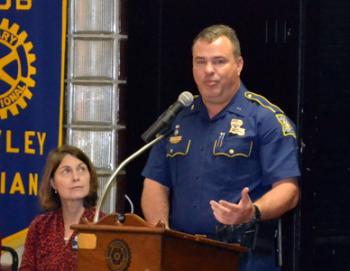
As Rotary Club of Crowley President Mary Zaunbrecher, seated, listens, Master Trooper Brooks David, public information officer with Louisiana State Police Troop I, speaks about the importance of wearing a seat belt and many other topics at the club’s weekly meeting.
David stresses seat belts importances to Rotary
Jeannine LeJeune is the online editor for the Crowley Post-Signal. She can be reached at jeannine.lejeune@crowleytoday.com or 337-783-3450.
Master Trooper Brooks David, public information officer for Louisiana State Police Troop I, can tell you the worst part of his job without a second thought – notification of a fatality to the next of kin.
“We hate making that notification,” he said. “There is no worst feeling in the world. There is nothing you can do about it.”
David spoke to the Rotary Club of Crowley this week and focused a great deal of his time on seat belt enforcement.
Reeling off national statistics, David pointed out how not wearing seat belts is the number one killer of teenagers whereas only 14 percent of seat belt wearers receive moderate to severe injuries.
“Five thousand teenagers a year die because of lack of seat belts,” he said. “If 5,000 children came down with an illness in the United States, we’d go crazy trying to figure out what we could do to stop that illness. But, for some reason, we don’t get in an uproar about seat belts, and it is the simplest thing in the world to do. It takes two seconds and I guarantee you it saves lives and the numbers show it.”
David stresses it is up to the leaders of the community, like the Rotarians — and parents, first and foremost — to drive home the importance of seat belts.
The fine for not wearing a seat belt – $25 – appears not to be doing much as a deterrent. As David pointed out Tuesday, many would rather pay the $25 than be bothered with putting on a seat belt. That means, the cause falls to changing the mentality toward seat belt wearing and usage.
“People are not getting the message in regards to seat belts,” he said.
“It starts with parents wearing a seat belt and showing their children and telling their children why it’s important,” he said.
David explained that when you are in a car accident, the seat belt not only halts your body’s forward momentum, but it also helps spread the impact across the body and not just in one centralized area.
After his address, David fielded questions from the Rotarians on several topics including:
• For children to sit in the front seat, they should be 12 years old.
“Usually, it’s 4-foot-9 (inches) when that seat belt can properly (and fully) restrain that child.”
• When speaking about automatic seat belt mechanisms, David wishes there would be something, but people have found ways around them before – putting something in the belt to stop the chiming, sitting on the belt. Even in the cars in which the seat belt would be lowered as the door closed, drivers would unfasten the shoulder strap use only the lap belts.
“Lap belts are not going to help,” said David. “They are not going to help a child. The worst thing you could do is put a lap belt on your child.”
• Drivers under the age of 18 are not allowed to use their phone at all while driving, drivers 18 years and older can use a phone to make calls, but not to text or use the Internet.
• When an emergency vehicle is pulled onto the shoulder, a vehicle in the left lane legally should get into the right lane on multi-lane highways. However, if that is not possible due to right lane traffic, the left-lane driver should slow his or her speed to 25 miles per hour below the speed limit for safety reasons.
• Also, in regard to multi-lane highways, drivers legally must stay in the right lane unless passing another vehicle, though troopers typically use common sense in the matter and allow drivers to travel in the left lane when traveling close to city limits (i.e. heading into Lafayette) and such.
- Log in to post comments
